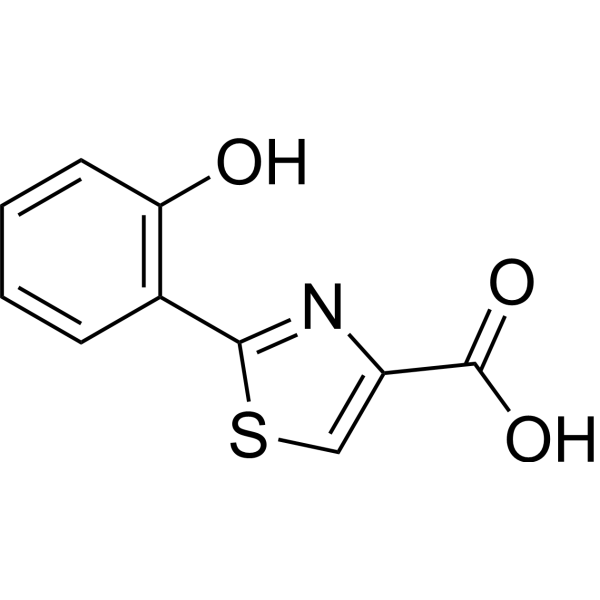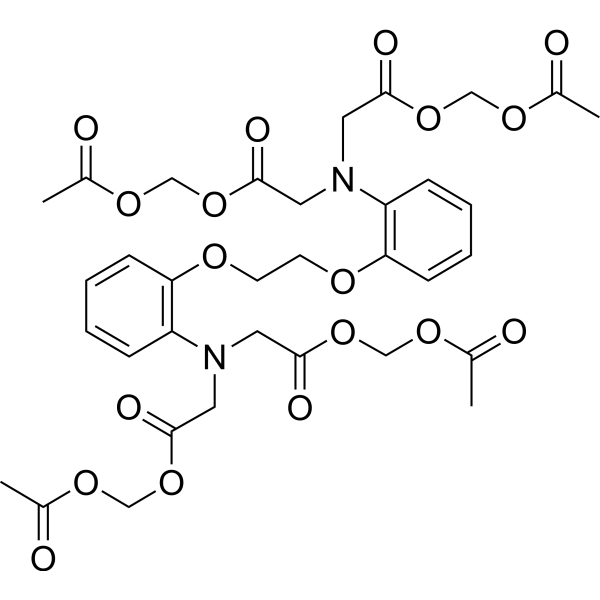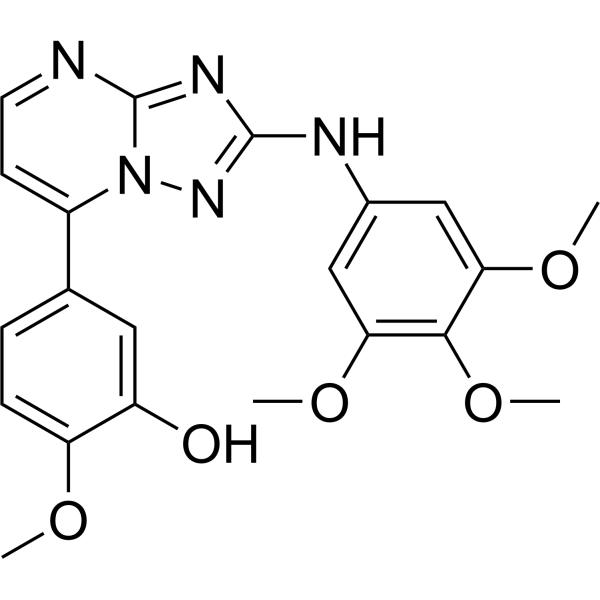- Anti-infection
- Antibody-drug Conjugate/ADC Related
- Apoptosis
- Autophagy
- Cell Cycle/DNA Damage
- Cytoskeleton
- Epigenetics
- GPCR/G Protein
- Immunology/Inflammation
- JAK/STAT Signaling
- MAPK/ERK Pathway
- Membrane Transporter/Ion Channel
- Metabolic Enzyme/Protease
- Neuronal Signaling
- NF-κB
- PI3K/Akt/mTOR
- PROTAC
- Protein Tyrosine Kinase/RTK
- Stem Cell/Wnt
- TGF-beta/Smad
- Vitamin D Related/Nuclear Receptor
- Others
Anti-infection
Apoptosis
Cell Cycle/DNA Damage
Epigenetics
GPCR/G Protein
- 5-HT Receptor
- Adenylate Cyclase
- Adhesion G Protein-coupled Receptors (AGPCRs)
- Adrenergic Receptor
- Amylin Receptor
- Angiotensin Receptor
- Apelin Receptor (APJ)
- Arf Family GTPase
- Arrestin
- Bombesin Receptor
- Bradykinin Receptor
- Cannabinoid Receptor
- CaSR
- CCR
- CGRP Receptor
- Chemerin Receptor
- Cholecystokinin Receptor
- CRFR
- CXCR
- EBI2/GPR183
Immunology/Inflammation
Membrane Transporter/Ion Channel
Metabolic Enzyme/Protease
- 11β-HSD
- 15-PGDH
- 17β-HSD
- 5 alpha Reductase
- Acetolactate Synthase (ALS)
- Acetyl-CoA Carboxylase
- Acetyl-CoA synthetase
- Acyltransferase
- ADAMTS
- Adiponectin Receptor
- Aldehyde Dehydrogenase (ALDH)
- Aldose Reductase
- Amine N-methyltransferase
- Aminoacyl-tRNA Synthetase
- Aminopeptidase
- Aminotransferases (Transaminases)
- Amylases
- Angiotensin-converting Enzyme (ACE)
- ANGPTL
- Apolipoprotein
Neuronal Signaling
Protein Tyrosine Kinase/RTK
Stem Cell/Wnt
- Compound Screening Libraries
- Bioactive Screening Libraries
- •Bioactive Compound Library
- Drug Repurposing Series
- •FDA-Approved Drug Library
- •Drug Repurposing Compound Library
- Natural Products Series
- •Natural Product Library
- •Natural Product-like Compound Library
- Metabolism Series
- •Human Endogenous Metabolite Compound Library
- Disease Related Compound Libraries
- Signaling Pathway Series
- Fragment Libraries
- Diversity Compound Libraries
- •50K Diversity Library
- •5K Scaffold Library
- •3D Diverse Fragment Library
- Virtual Screening
- •50K Virtual Diversity Library
- •10M Virtual Diversity Library
- Recombinant Proteins
- Cytokines and Growth Factors
- Immune Checkpoint Proteins
- CAR-T Related Proteins
- CD Antigens
- Fc Receptors
- Receptor Proteins
- Enzymes & Regulators
- Complement System
- Ubiquitin Related Proteins
- Viral Proteins
- Biotinylated Proteins
- Fluorescent-labeled Recombinant Proteins
- GMP-grade Proteins
- Animal-free Recombinant Proteins
- Protein Expression Service
- Custom Synthesis Service
- ADC-Related Custom Services
- PROTAC-Related Custom Services
- Cytokines and Growth Factors
- Immune Checkpoint Proteins
- CAR-T Related Proteins
- CD Antigens
- Fc Receptors
- Receptor Proteins
- Enzymes & Regulators
- Complement System
- Ubiquitin Related Proteins
- Viral Proteins
- Biotinylated Proteins
- Fluorescent-labeled Recombinant Proteins
- GMP-grade Proteins
- Animal-free Recombinant Proteins
- Others
- View More
CAR-T Related Proteins
- CD27 Ligand/CD70
- CD4
- CD19
- CD27 Ligand/CD70
- CD123
- CD138/Syndecan-1
- Epithelial Cell Adhesion Molecule (EpCAM)
- Folate Receptor 1
- GPC-3
- Guanylate Cyclase 2C
- ErbB2/HER2
- ErbB3/HER3
- c-Met/HGFR
- MSLN
- CA-125
- ROR1
- CEACAM-5
- CD314/NKG2D
- Prostate Specific Membrane Antigen
- CD319/SLAMF7
- TROP-2
- Siglec-6
- Folate Receptor alpha (FR-alpha)
- CD314/NKG2D
- Siglec-3/CD33
- CD27 Ligand/CD70
- CD319/SLAMF7
- ErbB2/HER2
- Siglec-3/CD33
- CD7
- MUC-1/CD227
CD Antigens
- T Cell CD Proteins
- B Cell CD Proteins
- NK Cell CD Proteins
- Macrophage CD Proteins
- Monocyte CD Proteins
- Stem Cell CD Proteins
- Platelet CD Proteins
- Erythrocyte CD Proteins
- Dendritic Cell CD Proteins
- Epithelial cell CD Proteins
- Endothelial cell CD Proteins
- Signal Transduction-related CD Proteins
- Cell Adhesion-related CD Proteins
Receptor Proteins
- Receptor Tyrosine Kinases
- Receptor Serine/Threonine Kinases
- Receptor Tyrosine Phosphatase
- Receptor Guanylyl Cyclase Family
- Cell Adhesion Molecules (CAMs)
- G-Protein-Coupled Receptors (GPCRs)
- Nuclear Receptor Superfamily
- Pattern Recognition Receptors
- Notch family
- Siglec
- Leukocyte Immunoglobin-like Receptors
- Killer-Cell Immunoglobulin-like Receptors
- Cytokine Receptors
Enzymes & Regulators
- Oxidoreductases (EC 1)
- Transferases (EC 2)
- Hydrolases (EC 3)
- Lyases (EC 4)
- Isomerases (EC 5)
- Ligases (EC 6)
- Translocases (EC 7)
- Matrix Metalloproteinases
- ADAMs/ADAMTSs
- Cathepsin
- Carboxypeptidase
- Angiotensin-converting Enzymes
- Caspase
- Carbonic Anhydrase
- Serine/Threonine Kinase Proteins
- Protein Tyrosine Kinases
- Phosphatase
- Topoisomerase
- Protease Inhibitors
- Protein Kinase Inhibitor Peptide (PKI)
- Cyclin-Dependent Kinase Inhibitor Proteins
- Cystatin Family
- Molecular Biology
- •Nucleic Acid Gel Electrophoresis
- •Vector Construction
- •Restriction Endonuclease
- •Materials
- •PCR & qPCR
- •RT-PCR
- •Sequencing
- Protein Biology
- •Protein Sample Preparation
- •Protein Purification
- •Protein Electrophoresis & WB
- •Labeling Kit
- •Multiple Fluorescent Staining
- •Immunoassay
- •Immunoprecipitation Kit
- Cell Biology
- •Cell Culture
- •Cell Analysis
- •3D Cell Culture
- •Cell Isolation
- View More
- Custom Synthesis Service
- Bulk and Custom Synthesis Service
- ADC-Related Custom Services
- PROTAC-Related Custom Services
- Custom Reference Standard Products
- Custom Peptide Synthesis
- Protein Expression Service
- Recombinant Antibody Expression Service
- Protein Crystal Structure Elucidation
- Oligonucleotide Synthesis
- Fluorescent labeling Service
- Custom Synthesis of Stable Isotope-Labeled Compounds
- One-stop CDMO Service
- One-stop Compound Screening Platform
- Virtual Screening
- Molecular dynamics simulation
- Cell-based Compound Screening
- Ion Channel Screening
- Kinase Screening Service
- Surface Plasmon Resonance (SPR) Assay Service
- GPCR Bioassay Screening Services
- Nuclear Receptor Screening Services
- Affinity Mass Spectrometry
- DEL Synthesis and Screening
- Molecular Interaction Assay Service
- Drug Target Identification Service
- AI-Driven Drug Screening
- Molarity Calculator
- Dilution Calculator







































































































































































































































































































































































































































































































































































































































































![[Glu1]-Fibrinopeptide B](http://file.medchemexpress.eu/product_pic/hy-p0308.gif)































































![ANP [Des18-22] 4-23 amide (rat)](http://file.medchemexpress.eu/product_pic/hy-p1526.gif)






















































































![[Pyr1]-Apelin-13, Gly(15N) TFA](http://file.medchemexpress.eu/product_pic/hy-p1033s.gif)































![[Orn8]-Urotensin II (human)](http://file.medchemexpress.eu/product_pic/hy-p1168.gif)






















































![[Pyr1]-Apelin-13, Pro(13C5,15N) TFA](http://file.medchemexpress.eu/product_pic/hy-p1033s1.gif)













































































![[Val4] Angiotensin III](http://file.medchemexpress.eu/product_pic/hy-p3910.gif)






























![[Deglycinamide9, Arginine8]-Vasopressin](http://file.medchemexpress.eu/product_pic/hy-106102.gif)






























![[Asn18] Endothelin-1, human](http://file.medchemexpress.eu/product_pic/hy-p3615.gif)









































![[Ac-Tyr1,D-Phe2]GRF 1-29, amide (human)](http://file.medchemexpress.eu/product_pic/hy-p0211.gif)


















































































































































































































































































![NH2-c[X-R-L-S-X]-K-G-P-(D-1Nal)](http://file.medchemexpress.eu/product_pic/hy-p3346.gif)























![[Lys4] Sarafotoxin S6c](http://file.medchemexpress.eu/product_pic/hy-p3563.gif)






























































































































































































































































































































































































































































































































































































































































![Quercetin-3-O-D-glucosyl]-(1-2)-L-rhamnoside](http://file.medchemexpress.eu/product_pic/hy-n7607.gif)

















































































































































































































































































































































































































































































































































































![[Orn5]-URP TFA](http://file.medchemexpress.eu/product_pic/hy-p1167a.gif)












































































































































































































































![[Orn5]-URP](http://file.medchemexpress.eu/product_pic/hy-p1167.gif)











































































![[Tyr6]-Angiotensin II](http://file.medchemexpress.eu/product_pic/hy-p5913.gif)



























































![NH2-c[X-R-L-S-X]-K-G-P-(D-2Nal)](http://file.medchemexpress.eu/product_pic/hy-p3347.gif)























































































































![[Sar1,Thr8]-Angiotensin II](http://file.medchemexpress.eu/product_pic/hy-p10640.gif)











































































![Lactalbumin B (50-53) Alpha [Lactorphin Alpha], bovine](http://file.medchemexpress.eu/product_pic/hy-p3976.gif)


















































































































![[Pyr1]-Apelin-13](http://file.medchemexpress.eu/product_pic/hy-p1033.gif)








































































































































































































































































































![[Mpr7, DAla9] ANP (7-28), amide, rat](http://file.medchemexpress.eu/product_pic/hy-p3772.gif)

















































![[Phe8Ψ(CH-NH)Arg9]-Bradykinin](http://file.medchemexpress.eu/product_pic/hy-103292.gif)










































































































































































































































































![[D-Trp11]-Neurotensin](http://file.medchemexpress.eu/product_pic/hy-p3057.gif)




![[Leu31,Pro34]-Neuropeptide Y (human,rat)](http://file.medchemexpress.eu/product_pic/hy-p1323.gif)









![[D-Pro4,D-Trp7,9,Nle11] Substance P (4-11)](http://file.medchemexpress.eu/product_pic/hy-p3805.gif)
















































![D[LEU4,LYS8]-VP TFA](http://file.medchemexpress.eu/product_pic/hy-p1163a.gif)






































































![D[LEU4,LYS8]-VP](http://file.medchemexpress.eu/product_pic/hy-p1163.gif)






























































































































































![[Leu31,Pro34]-Neuropeptide Y(human,rat,mouse) TFA](http://file.medchemexpress.eu/product_pic/hy-p1323a.gif)




























![[Ala1,3,11,15]-Endothelin (53-63) (TFA)](http://file.medchemexpress.eu/product_pic/hy-p1019a.gif)

















































![[Hyp3]-Bradykinin](http://file.medchemexpress.eu/product_pic/hy-p3061.gif)
























![Benzo[c][1,8]naphthyridin-6(5H)-one](http://file.medchemexpress.eu/product_pic/hy-115862.gif)



















































![[Sar1, Ile8]-Angiotensin II](http://file.medchemexpress.eu/product_pic/hy-p1564.gif)


































![[Ala1,3,11,15]-Endothelin (53-63)](http://file.medchemexpress.eu/product_pic/hy-p1019.gif)
































































































































































































































































































































































































































































































![1-Methyl-2-[(6Z,9Z)-6,9-pentadecadienyl]-4(1H)-quinolone](http://file.medchemexpress.eu/product_pic/hy-n9520.gif)

















































































![[Tyr8] Bradykinin](http://file.medchemexpress.eu/product_pic/hy-p3751.gif)


















































![[Tyr8]-Atrial Natriuretic Peptide (5-27), rat](http://file.medchemexpress.eu/product_pic/hy-p3774.gif)










































































































































































































































![1-Methyl-2-[(4Z,7Z)-4,7-tridecadienyl]-4(1H)-quinolone](http://file.medchemexpress.eu/product_pic/hy-n9530.gif)





































































































































































































































































































































































































































































































































































































































































































































































































































































































































































































































































